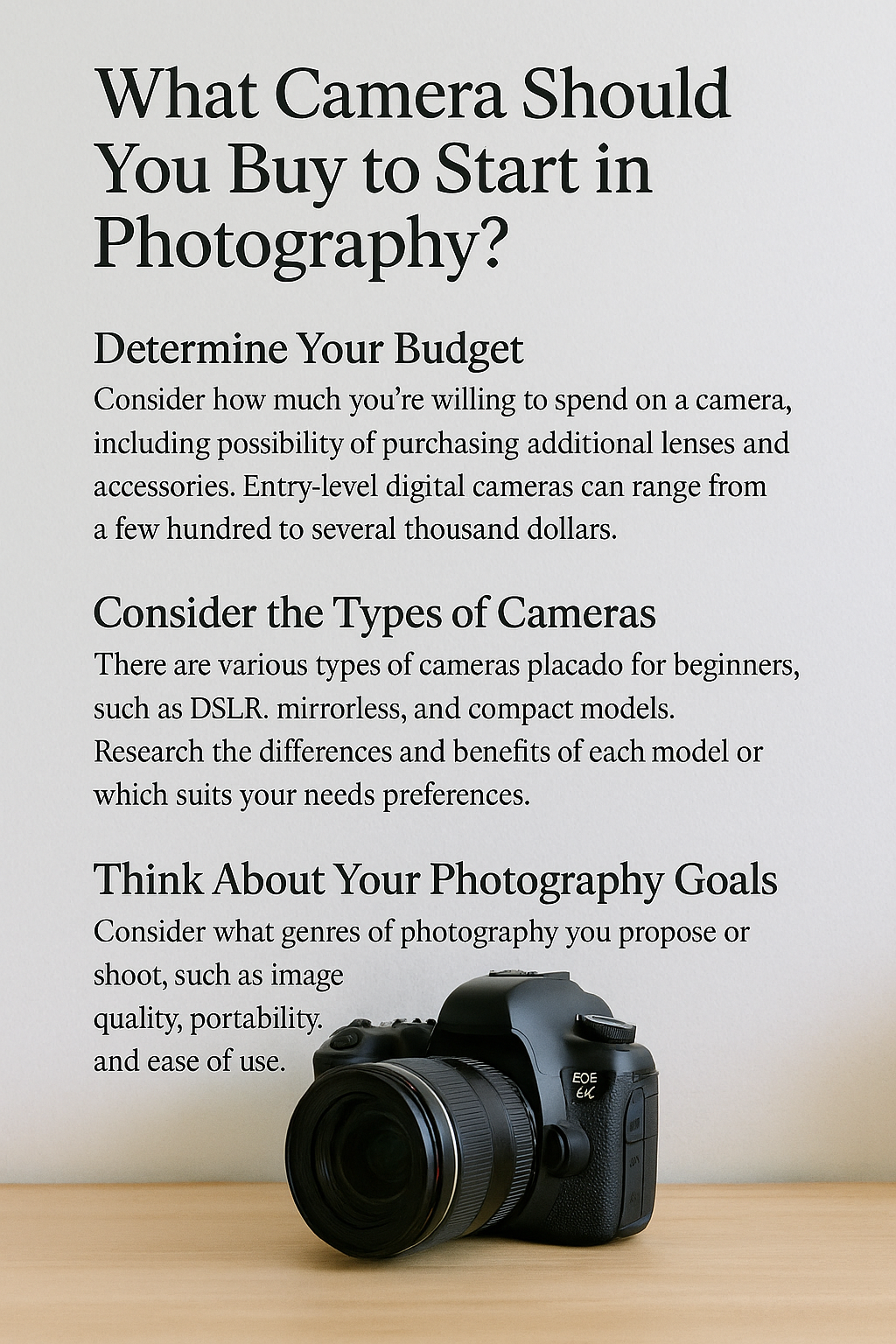Choosing your first camera is one of the most exciting moments for a beginner photographer. It marks the beginning of a new journey filled with learning, discovery, and creativity. But with so many options on the market, it’s easy to feel overwhelmed. From DSLRs to mirrorless systems and compact cameras, each type offers different features, advantages, and price points.
This article will help you understand what to look for in a beginner camera and guide you through some of the best options based on your needs and goals.
Know Your Purpose First
Before you browse through specs and prices, it’s important to identify what kind of photography you’re interested in. This will influence the type of camera that’s best for you.
Ask yourself:
Do you want to shoot landscapes, portraits, or street photography?
Are you interested in video as well as photos?
Do you plan to travel frequently with your camera?
Do you want full manual control or prefer simplicity?
Understanding your intent helps narrow your choices and ensures you pick something that suits your photography style.
The Main Types of Beginner Cameras
There are four major camera types that suit beginners. Each has strengths and weaknesses, so let’s break them down.
Smartphones
Believe it or not, many photographers today start their journey with a smartphone. With incredible improvements in camera quality and editing apps, phones like the iPhone 15 Pro or Google Pixel 8 Pro are great for learning the basics.
Pros:
Always accessible
Easy to share photos
Advanced computational photography
Cons:
Limited control over manual settings
Lack of interchangeable lenses
Lower image quality in low light
Point-and-Shoot Cameras
Point-and-shoots are compact and convenient. They’re great for casual photography and offer better image quality than most smartphones.
Pros:
Small and lightweight
Simple to use
Affordable
Cons:
Limited creative control
No interchangeable lenses
Not ideal for professional growth
DSLR Cameras
DSLRs are traditional and reliable. They offer great battery life, a wide selection of lenses, and full manual controls.
Pros:
Excellent image quality
Interchangeable lenses
Durable and time-tested
Cons:
Bulky and heavy
Older models may lack modern features
Top beginner models:
Canon EOS Rebel T7
Nikon D3500
Mirrorless Cameras
Mirrorless cameras are the modern evolution of DSLRs. They’re lighter, faster, and often include advanced features like better autofocus and 4K video.
Pros:
Lightweight and compact
Excellent for both photo and video
Real-time digital previews
Cons:
Shorter battery life
Lenses can be more expensive
Top beginner models:
Sony Alpha a6000
Canon EOS M50
Fujifilm X-T200
What Features Should You Look For?
As a beginner, some features will be more helpful than others. Focus on usability, flexibility, and long-term value rather than the highest specs.
Manual Controls
Being able to control shutter speed, aperture, and ISO is essential for learning photography.
Interchangeable Lenses
These let you experiment with different styles and subjects—from portraits to macro and wildlife photography.
Autofocus Performance
Fast and accurate autofocus is helpful, especially if you’re shooting movement or video.
Viewfinder
Electronic viewfinders (EVF) in mirrorless cameras let you preview exposure changes in real time.
Articulating Screen
A flip-out screen is great for vlogging, selfies, or creative angles.
Connectivity
Wi-Fi or Bluetooth helps you transfer photos easily to your phone or cloud storage.
Set a Budget That Makes Sense
Photography can be an expensive hobby, but you don’t need to overspend at the start.
Budget tips:
Under $300 – Consider a used DSLR or a mid-range compact camera
$300–$700 – Entry-level DSLRs and mirrorless models with kit lenses
$700–$1,200 – Advanced beginner options with better lenses, autofocus, and video
Also factor in the cost of:
Memory cards
Camera bag
Tripod
Extra batteries
Editing software
Consider the Used Camera Market
Buying used or refurbished gear is a smart way to save money. You can often find cameras in excellent condition for 30–50% less than new.
Where to buy:
KEH Camera
MPB
B&H Used
Facebook Marketplace (with caution)
Local camera stores
Check the camera’s shutter count, physical condition, and request a return policy if buying online.
Try Before You Buy
Visit a store and hold the cameras. See how they feel in your hands. A camera that’s comfortable and intuitive will encourage you to shoot more.
You can also rent a camera or lens for a weekend to test it in real-life scenarios. Rental services like Lensrentals or BorrowLenses are great for this.
Recommended Beginner Kits
Here are three starter kits depending on your needs:
Budget-Friendly
Camera: Canon EOS Rebel T7
Lens: 18–55mm kit lens
Accessories: 64GB SD card, basic bag, and tripod
Compact and Travel-Ready
Camera: Sony Alpha a6000
Lens: 16–50mm kit lens
Accessories: Extra battery, lightweight tripod
Content Creator (Photo + Video)
Camera: Canon EOS M50
Lens: 15–45mm kit lens
Accessories: Rode mic, LED light, and SD card
Avoid Common Beginner Pitfalls
Don’t fall into the trap of thinking more megapixels means better quality. Focus on:
Sensor size (APS-C is great for starters)
Ease of use
Room to grow as your skills improve
Also, don’t rush to buy too many accessories at once. Learn what your camera can do first—then upgrade intentionally.
Start With What You Have, Then Grow
If you already own a smartphone or an older camera, use it. Master the fundamentals: light, composition, and timing. You’ll learn more by practicing daily than by chasing perfect gear.
Once you’re more comfortable, you’ll naturally start to understand which features and tools are worth investing in.
The Best Camera Is the One You Enjoy Using
There’s no one-size-fits-all answer. The best beginner camera is the one that fits your hand, your budget, and your goals. Whether it’s a DSLR, mirrorless, or even your smartphone, what truly matters is that it inspires you to go out and shoot.
